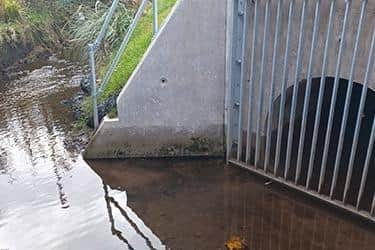Higher rainfall blamed for 10 million litres of sewage dumped in Fife
and live on Freeview channel 276
New data from the organisation has revealed that sewage was spilled 714 times in the Kingdom last year, releasing more than 10 million litres of sewage over the course of 9,400 hours.
The number of spills has more than tripled since 2022 when only 193 were reported. That 244% increase is higher than anywhere else in the country.
Advertisement
Hide AdAdvertisement
Hide Ad“Residents of Fife will be horrified by the huge increase in sewage dumping in Fife by Scottish Water, polluting our rivers and coastline,” said Lib-Dem Councillor James Calder (Dunfermline South).


Labour Councillor Altany Craik (Glenrothes West and Kinglassie) added that it’s “really disappointing” to see Fife suffering from high levels of dumping.
“It suggests to me that even though the Scottish Water bill goes up every year - 8.8% this year - we’re not getting the investment in the infrastructure that’s required to manage our sewer properly,” he said.
SNP opposition leader David Alexander (Leven, Kennoway and Largo) agreed that more needs to be done given the huge increase in rainfall over the last few years, but he argued that Scottish Water is still the best operator in Britain.
Advertisement
Hide AdAdvertisement
Hide Ad“The increase in rainfall has impacted hugely on Fife and elsewhere,” he said. “When it falls in winter and freezes it turns small potholes into monsters. When it forces an overflow there are also impacts.”
Scottish Water confirmed that higher levels of rainfall are taking its toll on the system.
“There was an increase in the number of overflows last year because of higher rainfall. Our network helps drain the rain away for communities,” said Professor Simon Parsons, Scottish Water’s director of environment, planning and assurance. Storm Babet was in October and that month was the wettest in Scotland on record - and we anticipate as the climate changes that rainfall will continue to overload our sewers.
Mr Parsons also highlighted that it’s not necessarily raw sewage and wastewater spilling out into the environment either.
Advertisement
Hide AdAdvertisement
Hide Ad“Around 99% of these overflows are rainwater, surface water, road run-off, grey water, infiltration of groundwater and trade effluent. More than half of the overflows we report in Fife are at locations where there has been treatment of the flows,” he said.
Scottish Water says it is “working with partners across Scotland to deliver new ways of managing surface water.” It is installing 1,000 additional monitors at discharge locations across the country and has a “clear commitment to invest further, monitor performance at more locations and strive to prevent pollution incidents before these happen.”
“We recognise releasing waste water, even occasionally, into Scotland’s rivers and seas is a concern to people and we are playing our part in fully informing the public, as well as improving infrastructure,” Mr Parsons said.
However, some councillors want more answers.
"The increase is a concern,” Conservative leader Kathleen Leslie (Burntisland, Kinghorn and Western Kirkcaldy) said. “Is something not working in terms of what Scottish Water should be doing? Are there things going into the sewage pipes causing this increase? Has something changed from last year?”
She added: “Rather than everyone shouting about who is to blame let's find out why and work with the relevant agencies to get it speedily amended.”
Comment Guidelines
National World encourages reader discussion on our stories. User feedback, insights and back-and-forth exchanges add a rich layer of context to reporting. Please review our Community Guidelines before commenting.